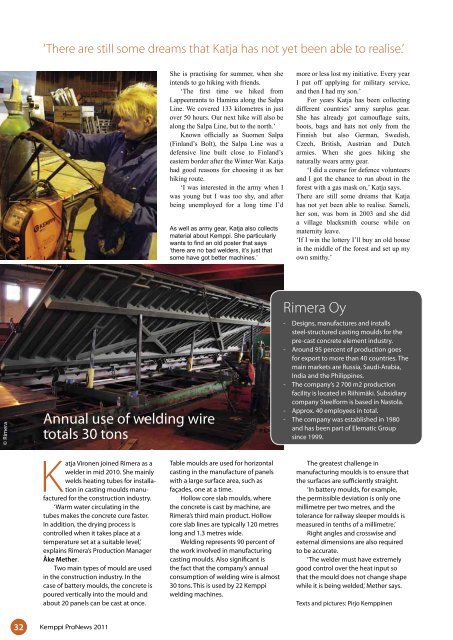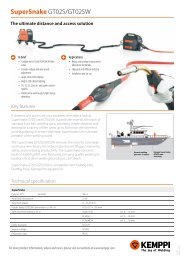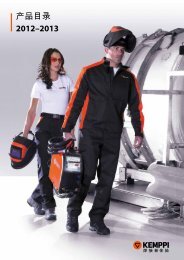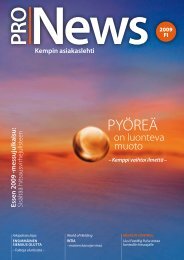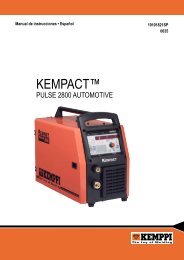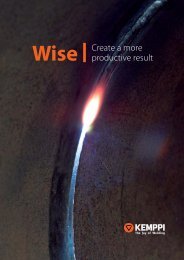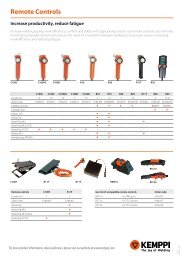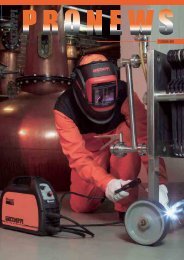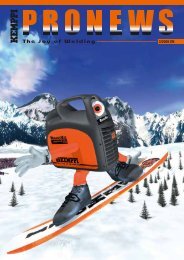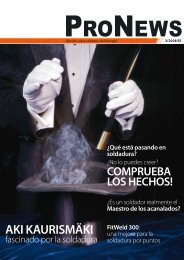Download - Kemppi Connections
Download - Kemppi Connections
Download - Kemppi Connections
Create successful ePaper yourself
Turn your PDF publications into a flip-book with our unique Google optimized e-Paper software.
‘There are still some dreams that Katja has not yet been able to realise.’<br />
She is practising for summer, when she<br />
intends to go hiking with friends.<br />
‘The first time we hiked from<br />
Lappeenranta to Hamina along the Salpa<br />
Line. We covered 133 kilometres in just<br />
over 50 hours. Our next hike will also be<br />
along the Salpa Line, but to the north.’<br />
Known officially as Suomen Salpa<br />
(Finland’s Bolt), the Salpa Line was a<br />
defensive line built close to Finland’s<br />
eastern border after the Winter War. Katja<br />
had good reasons for choosing it as her<br />
hiking route.<br />
‘I was interested in the army when I<br />
was young but I was too shy, and after<br />
being unemployed for a long time I’d<br />
As well as army gear, Katja also collects<br />
material about <strong>Kemppi</strong>. She particularly<br />
wants to find an old poster that says<br />
‘there are no bad welders, it’s just that<br />
some have got better machines.’<br />
more or less lost my initiative. Every year<br />
I put off applying for military service,<br />
and then I had my son.’<br />
For years Katja has been collecting<br />
different countries’ army surplus gear.<br />
She has already got camouflage suits,<br />
boots, bags and hats not only from the<br />
Finnish but also German, Swedish,<br />
Czech, British, Austrian and Dutch<br />
armies. When she goes hiking she<br />
naturally wears army gear.<br />
‘I did a course for defence volunteers<br />
and I got the chance to run about in the<br />
forest with a gas mask on,’ Katja says.<br />
There are still some dreams that Katja<br />
has not yet been able to realise. Sameli,<br />
her son, was born in 2003 and she did<br />
a village blacksmith course while on<br />
maternity leave.<br />
‘If I win the lottery I’ll buy an old house<br />
in the middle of the forest and set up my<br />
own smithy.’<br />
© Rimera<br />
Annual use of welding wire<br />
totals 30 tons<br />
Rimera Oy<br />
- Designs, manufactures and installs<br />
steel-structured casting moulds for the<br />
pre-cast concrete element industry.<br />
- Around 95 percent of production goes<br />
for export to more than 40 countries. The<br />
main markets are Russia, Saudi-Arabia,<br />
India and the Philippines.<br />
- The company’s 2 700 m2 production<br />
facility is located in Riihimäki. Subsidiary<br />
company Steelform is based in Nastola.<br />
- Approx. 40 employees in total.<br />
- The company was established in 1980<br />
and has been part of Elematic Group<br />
since 1999.<br />
Katja Vironen joined Rimera as a<br />
welder in mid 2010. She mainly<br />
welds heating tubes for installation<br />
in casting moulds manufactured<br />
for the construction industry.<br />
‘Warm water circulating in the<br />
tubes makes the concrete cure faster.<br />
In addition, the drying process is<br />
controlled when it takes place at a<br />
temperature set at a suitable level,’<br />
explains Rimera’s Production Manager<br />
Åke Mether.<br />
Two main types of mould are used<br />
in the construction industry. In the<br />
case of battery moulds, the concrete is<br />
poured vertically into the mould and<br />
about 20 panels can be cast at once.<br />
Table moulds are used for horizontal<br />
casting in the manufacture of panels<br />
with a large surface area, such as<br />
façades, one at a time.<br />
Hollow core slab moulds, where<br />
the concrete is cast by machine, are<br />
Rimera’s third main product. Hollow<br />
core slab lines are typically 120 metres<br />
long and 1.3 metres wide.<br />
Welding represents 90 percent of<br />
the work involved in manufacturing<br />
casting moulds. Also significant is<br />
the fact that the company’s annual<br />
consumption of welding wire is almost<br />
30 tons. This is used by 22 <strong>Kemppi</strong><br />
welding machines.<br />
The greatest challenge in<br />
manufacturing moulds is to ensure that<br />
the surfaces are sufficiently straight.<br />
‘In battery moulds, for example,<br />
the permissible deviation is only one<br />
millimetre per two metres, and the<br />
tolerance for railway sleeper moulds is<br />
measured in tenths of a millimetre.’<br />
Right angles and crosswise and<br />
external dimensions are also required<br />
to be accurate.<br />
‘The welder must have extremely<br />
good control over the heat input so<br />
that the mould does not change shape<br />
while it is being welded,’ Mether says.<br />
Texts and pictures: Pirjo <strong>Kemppi</strong>nen<br />
32 <strong>Kemppi</strong> ProNews 2011


